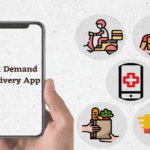When we analyze this innovation-driven world’s elements, even the idea of continuing without our darling cell phones and its applications makes us upset.
We are so used to applications and cell phones that we have made ourselves hugely reliant on them. We even need an application to make us walk enough steps, give reminders on when to drink water, or get us up toward the beginning of the day through alarms.
Would you be able to envision not living with them? Returning to the 80s?
It’s a difficult call, frankly.
This reliance has given a sheer benefit to every android app development company. Clearly, who wouldn’t wish to get in business at such an exceptionally favored market.
For what reason did we focus on Android and not other operating systems?
Well, there’s a reason,
Analyzing the overall industry’s current share, the two most conspicuous winners in the app development fields are Android and iOS. According to IDC.com’s report for 2019, Android holds an astounding 86.1% share of the market, while iOS has a decent 13.9%.
The insights are the clear proof of the phenomenal abilities android app development holds.
It outperforms iOS in pretty much every aspect, from user reach to better accessibility to affordability- Android wins all!
It is worthless to be distrustful about whether you should build up your application in Android or not. The decision is clear; if you plan to scale rapidly, there’s just one thing to do: Android app development.
Now is the time to focus on one of the most vital questions of this write-up- How to take android application development forward?
Well, it’s not that tough a task. As long as you understand how forward and have a detailed roadmap to guide you through the process, you are good to go.
So let’s start with what’s the most important, a detailed guideline.
Step 1: Download the “needed” tools for Android App Development:
The first thing you need to do is, create a development environment so that your desktop becomes ready to support you while developing your android application. For this, you may need Android Studio or Android SDK for support. Thankfully, you can find both of them packed together on the web, in one download.
The Android Studio refers to an IDE (Integrated Development Environment); this IDE is an interface wherein a developer can integrate the code, after which all the necessary tools can be accessed.
The Android studio allows the developer to access all libraries and APIs in the Android SDK, thereby providing access to all native functions of the operating system.
The developer you hire will be able to develop your application in APK using Gradle, test it through the “virtual device,” and debug the code while it runs.
You can also take some help from a nonprofit app development company to take android app development further.
Step 2: Start a New Project:
Once you have set up an Android studio on your device, the next step is to start a new project. This process is pretty convenient. However, you will have to make some decisions that may impact your android app development process.
Go to File, then to New, and start the New Project. The next thing to do is to select a “project template.” This will define the UI elements and codes included in your freshly developed application as soon as it loads.
Make sure to look for common elements of an android application like the button in the bottom or the hamburger menu on the top. Remember to look for the “activity” (screen) on your application, since a project with “No Activity” will be empty.
Keeping all this in mind before you head on to android app development can save you a lot of time.
Choosing between Java and Kotlin:
One of the major decisions all entrepreneurs and developers have to make is to choose between Kotlin and Java. Google and Android Studio support both the languages; however, they have different pros and cons.
Before choosing one, you should analyze all the advantages and disadvantages of both languages.
Step 3: Familiarize yourself with the files:
Many developers find the post android studio loading process a bit perplexing. There are various files, numerous kinds of codes, folders, and much more. These files are far away from the regular files that are used in Python.
All the folders you will come across are equally crucial in android app development as they pave the way for Gradle and Android studio to find everything and develop it correctly. Obviously, the File can’t be just renamed, you’ll have to work on it.
Or you can go to a nonprofit android app development company to help you understand the functionality of each android file.
The Layout Files:
The code is responsible for telling Android where all the associated files are. A layout file varies from those of Kotlin/Java. This process defined how an activity would look and allows a developer to add functionalities such as buttons, browser windows, and texts.
The other folders:
There are a lot more folders and files that you would have to be familiar with. However, you will find them once you start working with Android.
Some essential things you must know are:
- The Android Manifest: This is an XML file found in the res folder. It comprises all the essential features of your app; these include your app’s orientation, version, all that you need to have, etc.
- Drawable: You can find this folder in res. This will include all the images that you may need for reference purposes later in the development process.
- Values: The value folder would hold all the values in your application that would be used globally in your app, like color codes or strings. These values will be defined in individual XML files.
- Gradle: It is a tool that collects all your files and combines them into a workable APK testing. This is exceptionally useful for generating previews. The files in here won’t come to your use often; however, when you need to add a discrepancy, this is where you would have to go.
Step 4: Test Your App:
Your application will not perform at the highest if you fail to get it through rigorous testing. Make sure your product is free of bugs and glitches before turning it into a “final product.”
If you fail to fix all flaws before you launch your application for the world to use, you will end up creating a bad reputation for your brand. This one fail can become your identity, and all your future projects would be judged based on this.
And if you can deliver a flawless application to your users, they would instantly fall in love with your android app. To make sure your app has no bugs, you can ask an android app development company to test your app and fix the glitches.
Step 5: Launch it!
Once you have a “ready” application at your disposal, you must strategize your marketing plan really well. Make sure to have a full-proof plan based on market analysis, current competition, constraints, risks, and opportunities that may come your way. All these factors must be carefully analyzed before you implement anything. Once you have a solid plan, a good marketing team, and a bang-on application, nothing can stop you from attaining success.
Conclusion:
Android app development is purely a game of strategy, knowledge, experience, and hard work. If you have all of those to put in, there is no way you can lose out in the competition. The statistics of market share Android holds clearly indicate how much the users appreciate the operating system. Therefore, there would be nothing better than attaching your name to the brilliant platform. Since the audience is already in love with Android, there are high chances that they’ll fall in love with your application as well, considering you have a great idea, and you have developed your application right.
Don’t think twice before employing a nonprofit app development company to build your app the way it needs to be built.













